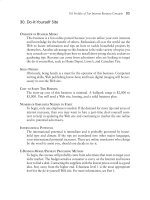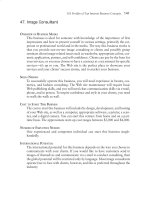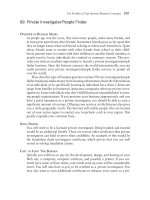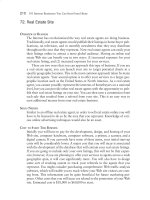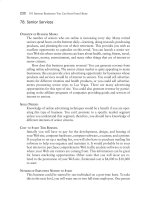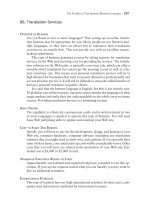the work from home handbook, flex your time improve your life (2008)
Bạn đang xem bản rút gọn của tài liệu. Xem và tải ngay bản đầy đủ của tài liệu tại đây (1.63 MB, 152 trang )
by Diana Fitzpatrick & Stephen Fishman
Flex Your Time, Improve Your Life
The
FROM
The
FROM
Work
HOME
Handbook
First Edition FEBRUARY 2008
Editor ILONA BRAY
Cover & Book Design SUSAN PUTNEY
Proofreading ROBERT WELLS
Index BAYSIDE INDEXING SERVICE
Printing DELTA PRINTING SOLUTIONS, INC.
USA TODAY CONTRIBUTORS
Book Editor BEN NUSSBAUM
Contributing Editors JIM HENDERSON, FRED MONYAK,
AND GERI TUCKER
Special thanks to JULIE SNIDER
Fitzpatrick, Diana
Work from home handbook / by Diana Fitzpatrick & Stephen Fishman.
p. cm.
ISBN-13: 978-1-4133-0701-6 (pbk.)
ISBN-10: 1-4133-0701-9 (pbk.)
1. Home-based businesses Handbooks, manuals, etc. 2. Telecommuting
Handbooks, manuals, etc. I. Fishman, Stephen. II. Title.
HD2333.F59 2008
658’.0412 dc22
2007035635
Copyright © 2008 by Nolo. ALL RIGHTS RESERVED. PRINTED IN THE U.S.A.
USA TODAY®, its logo, and associated graphics are federally registered trademarks. All rights are
reserved. All USA TODAY text, graphics, and photographs are used pursuant to a license and
may not be reproduced, distributed, or otherwise used without the express written consent of
Gannett Co., Inc.
No part of this publication may be reproduced, stored in a retrieval system, or transmitted in any
form or by any means, electronic, mechanical, photocopying, recording, or otherwise without
prior written permission. Reproduction prohibitions do not apply to the forms contained in this
product when reproduced for personal use.
For information on bulk purchases or corporate premium sales, please contact Nolo’s Special Sales
Department. For academic sales or textbook adoptions, ask for Academic Sales. Call 800-955-4775
or write to Nolo, 950 Parker Street, Berkeley, CA 94710.
Acknowledgments
Many thanks to Ilona Bray for her superb editing and Susan Putney for
the wonderful layout and design work.
About the Authors
Diana Fitzpatrick is a lawyer and legal editor of Nolo’s small business
books. Before joining Nolo, Diana worked for the city attorney’s office
in San Francisco.
Stephen Fishman is a San Francisco-based attorney
who is the author of many Nolo books, including Deduct It! and Tax
Deductions for Professionals, winner of the Independent Book Publishers
Association (PMA)’s Benjamin Franklin Award in 2007.
Table of Contents
I
Can You Really Make It Work? 1
1
Working at Home: e Win-Win Solution 3
How Your Company Wins 4
How You and Your Family Win 6
2
Are You Ready for Life Without the Water Cooler? 13
Part- or Full-Time Telework? 14
Will You Like Flying Solo? 15
Being Your Own Boss 17
Stepping Off the Fast Track 18
Where Will the Desk Go? 20
Getting Out of the House 21
Who Will Mind the Kids? 22
3
Can You Do Your Job at Home? 25
Desk Jobs Work Best 26
Can You Be a Team Player From Home? 29
Can Your Job Be Neatly Scheduled? 30
Does Your Job Require Personal or Client Contact? 31
What Equipment Will You Need? 32
Does Business Travel Already Take You Away From the Office? 33
If Your Current Job Isn’t Teleworkable 34
4
Making Your Case 39
Is Your Office Ready for Teleworkers? 40
Transform Your Personal Reasons Into Business Reasons 42
Line Up the Facts at Support Teleworking 47
Writing Up Your Telework Proposal 50
Presenting Your Proposal 63
Be Ready for Objections 64
5
Finding a New, Teleworkable Job 69
Find a Telework-Friendly Employer 70
Find an Advertised Work-at-Home Job 73
Telework Jobs You Might Not Find Advertised 76
Avoid Schemes and Scams 85
6
Go Freelance! 91
Is Freelancing for You? 93
Finding at First Freelance Job 98
Setting Rates 99
Entering into Client Agreements 101
Taxes for Freelancers 108
7
Telework and Taxes 125
Paying for Your Work-Related Expenses 126
e Home Office Deduction 130
Working for an Employer in Another State 132
Filing Your Taxes 133
8
Strategies for Work-at-Home Success 135
Ready, Set, What? 136
Draw Limits for Friends and Family 137
Show Your Stuff 138
Come Out of Your Cave 139
Keep Yourself in the Loop 141
Don’t Hit “Send” When You’re Mad 142
Check in With Yourself 142
Check in With Your Manager and Coworkers 144
Explore the Possibilities 144
Index 147
I
introduction
Can You Really Make It Work?
D
oes the prospect of working from home sound too good to
be true? Well, it shouldn’t. is book will show you how
almost anyone can restructure or change their working
life so that they can work at home, either full or part time, for an
employer or as a freelancer.
is major life change may take patience, creativity, and a little
sacrifice. But before long, you could be commuting from the kitchen
to your home office, a cup of coffee in your hand and the sun
shining through your window. We’ll explain:
• whattypeofpersonalitytraitswillhelpyousucceedasa
teleworker
• whetheryourcurrentjobcanreallybedonefromhome,and
• howtoconvinceyouremployerthatteleworkingisagreatidea
for both you and the company.
And, if you can’t or don’t want to stay at your current job, we’ll
show you how to either:
• lookforajobthatyoucanturnintoawork-at-home
opportunity
• strikeoutonyourownasahome-basedfreelancer,or
• ndanadvertisedwork-at-homejobthatsuitsyourexperience
and needs.
is book gives you the nuts and bolts of what it takes to make
it as a teleworker. Regardless of your skills, work experience, or
background, you can do it, and this book can help you. ●
1
cHAPtEr
Working at Home:
e Win-Win Solution
How Your Company Wins 4
How You and Your Family Win
6
Do more (and better) work in less time
7
No more commuting your life away
7
Work on your own schedule
10
Find work-life balance
11
cHAPtEr 1
|
WORKING AT HOME: THE WINWIN SOLUTION
|
5
4
|
THE WORK FROM HOME HANDBOOK
cHAPtEr 1
|
WORKING AT HOME: THE WINWIN SOLUTION
|
5
4
|
THE WORK FROM HOME HANDBOOK
N
o matter how much you like your office job, getting back and
forth to work each day can be sheer drudgery. And the total
hours you spend at work, away from home and loved ones,
probably add up to over 40 per week. If this lifestyle is wearing on
you, there’s a powerful alternative: working from home. Even if you
stay home only one or two days a week, it can help you reclaim your
life by saving you time, money, and unnecessary stress. Imagine having
no train schedule to follow, no shirt to press, no rush-hour traffic to
contend with. Instead, you could start your day with a trip to the gym
or a leisurely cup of coffee while reading the newspaper. en, when
you were ready, you could settle down to some productive work.
Just a few short years ago, the only people able to enjoy the benefits of
working from home were either self-employed or doing menial contract
work—your basic envelope stuffing. Today, high-speed Internet access,
wireless laptops, and BlackBerrys for remote email have made it possible
for many people to work anytime and anywhere—whether from a home
office in Bangor, Maine, or an airport in Bangkok, ailand.
And the world is catching on. Leading U.S. employers are realizing
that telework (also called telecommuting) offers benefits for them
as well, as their teleworkers become happier and more productive
employees. is book will show you how to join the tens of thousands
of people who have done what it takes—negotiated with their boss,
found a new job, or begun freelancing—to work at home and find
balance in their lives.
How Your Company Wins
ese days, employers who know they can be in instant communication
with their employees through BlackBerrys, instant messaging, and
wireless laptops don’t worry that teleworkers will spend their days
raiding the fridge or watching soap operas. ey’re also seeing that
modern technology allows employees to be productive no matter
where they are. e result is that more employers are focusing on the
cHAPtEr 1
|
WORKING AT HOME: THE WINWIN SOLUTION
|
5
4
|
THE WORK FROM HOME HANDBOOK
cHAPtEr 1
|
WORKING AT HOME: THE WINWIN SOLUTION
|
5
4
|
THE WORK FROM HOME HANDBOOK
work being done rather than the number of hours spent at a desk. e
numbers tell the story of this trend:
• 12.4millionemployees—roughly8%oftheAmerican
workforce—worked from home at least one day a month in 2006.
• Wellovertwo-thirdsofallU.S.companiesoeredsometelework
options in 2005.
Employers who’ve given telework a try often report that teleworkers
are actually more productive than their counterparts in the office.
Airplane manufacturer Boeing found that average work productivity
increasedbetween15%and30%,
andIBMobserveda10%and
20%increaseinproductivity.At
AT&T—a company at the forefront
of the telework movement—
managers who telework have
consistently reported gaining one
hour of productive work for every
day they work from home.
Productivity increases are not
the only upside for employers.
Companies that offer telework
save money on office space because
teleworkers often share space with
other employees or give up their offices entirely. Offering telework has
also become an effective tool for recruiting and retaining employees at
all levels. is is particularly true as both gasoline prices and housing
costs have risen, forcing employees to live far from their workplaces and
making their commutes more expensive.
Another boost to teleworking came in the aftermath of the September
11th terrorist attacks and Hurricane Katrina, when companies in the
affected areas scrambled to remain operational. ey realized that their
off-site workplaces and workers were largely responsible for keeping
them functional.
America’s best employers
are catching on.
Seventy-nine of the firms on
Fortune Magazine’s 2006 list of
“100 Best Companies to Work For”
allow employees to work from
home at least 20% of the time. e
country’s largest employer—the
U.S. government—encourages its
employees to work from home “to
the maximum extent possible.”
cHAPtEr 1
|
WORKING AT HOME: THE WINWIN SOLUTION
|
7
6
|
THE WORK FROM HOME HANDBOOK
cHAPtEr 1
|
WORKING AT HOME: THE WINWIN SOLUTION
|
7
6
|
THE WORK FROM HOME HANDBOOK
Telework is also socially responsible: Environmental concerns, particu-
larly global warming and energy consumption, have provided another
impetus to telework. Employers and
employees alike have come to see
telework as a way to reduce fuel con-
sumption and other environmental
impacts and also help clear up our
overcrowded roads. A study commis-
sioned by the Consumer Electronics
Assocation found that the estimated
3.9 million full-time teleworkers in
the U.S. reduced gasoline consump-
tion by about 840 million gallons
and carbon dioxide emission by almost 14 million tons—the equivalent
of taking 2 million vehicles off the road per year.
TIP
Telework can provide employment opportunities for
disabled persons. In fact, if a disability prevents you from doing a
job on-site, federal law may be on your side. e Americans with
Disabilities Act (ADA) requires employers with 15 or more employees
to provide reasonable accommodation for employees or qualified
applicants with disabilities. One way employers may be able to meet
this legal obligation is to offer telework. For more on using telework as a
reasonable accommodation, see www.eeoc.gov/facts/telework.html.
How You and Your Family Win
It’s amazing how a simple change can transform your life. By taking
your work home, you can find more time to spend with your family,
more flexibility to pursue your interests outside of work, and more
satisfaction with your life at work. To put it simply, working from home
is a win-win solution.
For every 37 miles not driven, a
teleworker will avoid generating one
pound of air pollution. If just 10% of
U.S. residents worked at home one
day per week, the country would
conserve a whopping 1.2 million
gallons of fuel per week.
cHAPtEr 1
|
WORKING AT HOME: THE WINWIN SOLUTION
|
7
6
|
THE WORK FROM HOME HANDBOOK
cHAPtEr 1
|
WORKING AT HOME: THE WINWIN SOLUTION
|
7
6
|
THE WORK FROM HOME HANDBOOK
Do more (and better) work in less time
As we all know, it’s not always easy to get work done at the office. ere’s
rarely quiet time during regular business hours to sit and concentrate.
Office workers are regularly
interrupted by ringing phones,
impromptu meetings, and coworkers
popping by to chitchat. is can be
as frustrating for an employee as it is
for the employer who is paying for
this nonproductive work time.
Working at home can free you
from these distractions, giving you
long blocks of time to focus on
your work. (Of course, your home
may present its own distractions,
but we’ll talk later about ways
to deal with those.) Ideally, your
productivity will increase, as will the quality of your work product. At
the same time, you’ll get to enjoy the personal satisfaction of focusing
on your work and getting it done.
No more commuting your life away
It’s depressing but true: U.S. workers actually spend more time commut-
ing than vacationing each year. e average employed American com-
mutes more than 24 minutes each way, losing the better part of an hour
in transit every work day. Workers in major U.S. cities often spend even
more time getting to and from work. Topping the list are New York City
residents, who waste an average of 76.6 minutes on their daily commutes.
Let’s suppose your commute to work is half an hour door to door.
Over the course of a year, that would add up to 240 hours on the road—
the equivalent of six 40-hour work weeks! ose are six weeks you could
have spent enjoying your backyard or training for a marathon.
Extreme commuting,
anyone?
Because of the sky-high cost of
real estate in many communities,
some commuters are willing to
travel more than 90 minutes
each way just so they can afford
a decent home. In Baltimore,
for example, over 5% of workers
endure “extreme” commutes of
more than three hours a day.
cHAPtEr 1
|
WORKING AT HOME: THE WINWIN SOLUTION
|
9
8
|
THE WORK FROM HOME HANDBOOK
cHAPtEr 1
|
WORKING AT HOME: THE WINWIN SOLUTION
|
9
8
|
THE WORK FROM HOME HANDBOOK
RESOURCE
Commuting is bad for your social life. For every ten minutes
we spend commuting, our social connections are cut by 10%. Find
out more in Bowling Alone: e Collapse and Revival of American
Community, a book by Harvard University Professor Robert Putnam.
Save money.
Everyone is feeling the effects of high gas prices, but few
are hit as hard as commuters. For some, keeping their tank filled now
costs as much as a mortgage payment. Some employers have responded
with programs that promote mass transit, shuttle buses, carpools, and,
in some cases, teleworking. For example, e National Recreation and
Park Association, a Virginia-based nonprofit, came up with a once-
a-week telework option for all of its 70 workers. Employees are also
taking action. In a recent survey
of 2,000 at-home call center
agents,36%saidgasprices
drove their decision to work at
home.
Another major commuter-
related cost is housing. Housing
costs have gone through the
roof. Nearly half of all renters,
according to the 2005 Census,
arespending30%ormoreof
their gross income on housing.
And over a third of homeowners
with mortgages are spending
a similar amount on their
house and related expenses. is means that a family earning $60,000
would be spending $18,000 or more just on rent or mortgage and tax
payments.
e best jobs tend to be in or near metropolitan centers—which is
also where real estate prices are highest. All too often, we’re left to choose
between a staggeringly high mortgage and an unbearably long commute.
cHAPtEr 1
|
WORKING AT HOME: THE WINWIN SOLUTION
|
9
8
|
THE WORK FROM HOME HANDBOOK
cHAPtEr 1
|
WORKING AT HOME: THE WINWIN SOLUTION
|
9
8
|
THE WORK FROM HOME HANDBOOK
RESOURCE
Calculate the cost of your commute. To find out how much
you could save by not driving to work each day, Commuter Challenge
has a terrific calculator at www.commuterchallenge.org. Click the
“Commuters” tab, then “Commute Cost Calculator.”
Reduce stress.
Work is stressful enough. Add the challenge of a tough
commute, and it’s no wonder so many people feel like they’re hanging
off the edge of a cliff. Unless you’re
one of the lucky few who can walk or
bicycle to work, your daily commute
is probably one of the most unpleasant
parts of your day. If you drive, you
may have to contend with rush hour
traffic, the daily aggressions of other
drivers, and the challenges of driving
in rain, sleet, and snow. If you take
mass transit, you may have the constant
worry of missing your departure, the
discomfort of sitting (or standing)
in cramped quarters next to perfect
strangers, or the hassle of switching
trains or buses.
Studies show that this daily strain can pack a serious wallop to your
physical and emotional health. In fact, commuters may be under more
stress than riot police and combat pilots. Hewlett Packard researcher
Dr. David Lewis explains that riot policemen and combat pilots “have
things they can do to combat the stress that is being triggered by the
event. But the commuter, particularly on a train, cannot do anything
about it at all.” Sound familiar? e result can be high blood pressure
and other physiological and psychological effects.
cHAPtEr 1
|
WORKING AT HOME: THE WINWIN SOLUTION
|
11
10
|
THE WORK FROM HOME HANDBOOK
cHAPtEr 1
|
WORKING AT HOME: THE WINWIN SOLUTION
|
11
10
|
THE WORK FROM HOME HANDBOOK
If the stress of commuting were to end when you reached your des-
tination, then perhaps it wouldn’t be so worrisome. But commuting
stress spills out and affects other
areas of life, too. Workers with
long commutes are likely to de-
velop problems with their health,
sleep patterns, and family and
social relationships. ese side
effects are particularly hard on
women, many of whom are al-
ready stressed to the max by the
competing demands of work and
family.
Reclaim lost time. Gaining
time to do the things you love is
one of the biggest advantages to
working at home. ose formerly
lost hours might be spent
volunteering at your local soup
kitchen, kicking around a football
with your son, or catching up on
some reading. And you also gain
those little pockets of time during the day—your former coffee breaks,
lunch hour, and bored moments staring at a computer screen trying to
look busy. Instead of standing around the water cooler or comparing
notes on the latest TV series, you can use those free moments at home
to plan your next vacation or throw in a load of laundry. Suddenly, your
chores and errands can fit seamlessly into your day.
Work on your own schedule
Depending on the nature of your job, working from home might give
you the flexibility to work during the hours that make the most sense
for your life. If you’d like your afternoons free to spend with your
children after school, you could choose to start your workday at 7 a.m.
cHAPtEr 1
|
WORKING AT HOME: THE WINWIN SOLUTION
|
11
10
|
THE WORK FROM HOME HANDBOOK
cHAPtEr 1
|
WORKING AT HOME: THE WINWIN SOLUTION
|
11
10
|
THE WORK FROM HOME HANDBOOK
and end it by 3 p.m. Or if you’d like to get in an early morning swim
or a round of golf, you might make up the missed time by working into
the early evening. Whatever your lifestyle, working at home can free
you to accomplish more in your day
without compromising the time you
put into your work.
Find work-life balance
Balancing work with the rest of our
lives can be just plain hard. Many
of us feel like there simply aren’t
enough hours in the day. Going
in to work—and being away from
home for long stretches—has a great
deal to do with these feelings. We spend hours on the road, have little
flexibility in how and when we work, and often don’t see the ones we
love before dinnertime.
Look How Hard We’re Working
For too many, the 40-hour workweek is a distant memory. On
average, men now work 49 hours a week and women 43.5 hours.
What’s more:
• 67%ofemployeessaytheydon'thaveenoughtimewiththeir
children
• 55%ofemployeessaytheydon'thaveenoughtimeforthemselves
• 45%ofemployeesfeelpulledandstretchedthinbetweentheir
responsibilities at home and at work, and
• 37%ofemployeessayit’shardtotaketimeoduringthe
workday when personal or families issues arise.
Source: Testimony from Ellen Galinsky, President, Families and Work Institute, to the
Subcommittee on Children & Families of the U.S. Senate Health, Education, Labor &
Pensions Committee in 2004 ( />Commuting more
stressful than in-laws?
Close to half of British commuters
studied said that rush hour traffic
was the single most stressful part
of their lives—worse than work
issues, money problems, and
family conflicts.
cHAPtEr 1
|
WORKING AT HOME: THE WINWIN SOLUTION
|
12
12
|
THE WORK FROM HOME HANDBOOK
Given the many benefits of working from home, it’s no wonder that
teleworkers are much happier with their jobs and their lives than their
counterparts at the office. An
AT&T study found that almost
two out of three teleworkers
(63%)weremoresatised
with their jobs after they
started working from home,
and an even higher percentage
were happier with their lives
outside of work. A study by
IBM uncovered similar results:
Teleworkers were the group who
anticipated staying with the
company the longest and had
the highest job satisfaction. ●
2
cHAPtEr
Are You Ready for Life Without
the Water Cooler?
Part- or Full-Time Telework? 14
Will You Like Flying Solo?
15
Being Your Own Boss
17
Stepping Off the Fast Track
18
Where Will the Desk Go?
20
Getting Out of the House
21
Who Will Mind the Kids?
22
cHAPtEr 2
|
ARE YOU READY FOR LIFE WITHOUT THE WATER COOLER?
|
15
14
|
THE WORK FROM HOME HANDBOOK
cHAPtEr 2
|
ARE YOU READY FOR LIFE WITHOUT THE WATER COOLER?
|
15
14
|
THE WORK FROM HOME HANDBOOK
W
orking from home is much more than just a new way of
getting your job done. It’s a complete lifestyle makeover—a
transformation of the way you spend your valuable hours
and days. No longer will there be a strict separation between work
and the rest of your life. Instead, the two will become inextricably
intertwined, for better and for worse. Yes, you’ll be able to take an
afternoon break to walk your dog, but you might also have to field an
important conference call while your dog is barking, and perhaps go
back to your computer late in the evening to make up for an extra-long
midday stroll.
Like any lifestyle choice, working from home isn’t for everyone. is
chapter will help you assess whether or not you’ve got the personality
traits and work habits shared by the happiest and most successful
teleworkers. You might conclude that you’re the perfect candidate for
a full-time, work-at-home career. Or, you might realize that you’re not
quite ready to cut your ties to the office, so that part-time telework is the
way to go. You might even decide that telework simply isn’t for you. But
many people find that the effort is worth it. After all, there’s no office on
earth that can offer the freedom, flexibility, and convenience of one in
your own home.
TIP
Focus on how you work best—not just the work itself. For the
moment, don’t worry about whether your current job is one that can
be done outside an office. We’ll consider your job’s “teleworkability” in
the next chapter.
Part- or Full-Time Telework?
If you want to reap the benefits of working from home but aren’t sure
you’re ready to completely cut out from an office environment, part-
time telework may offer the best of both worlds. Working from home
just a day or two each week can give you the work-life flexibility you’re
cHAPtEr 2
|
ARE YOU READY FOR LIFE WITHOUT THE WATER COOLER?
|
15
14
|
THE WORK FROM HOME HANDBOOK
cHAPtEr 2
|
ARE YOU READY FOR LIFE WITHOUT THE WATER COOLER?
|
15
14
|
THE WORK FROM HOME HANDBOOK
looking for and relief from the daily grind of commuting. Going into
the office on the other days may be all you need to still feel connected
and able to take on high-level projects and advance through the ranks.
A recent national poll found
that59%ofU.S.workers
consider part-time telework to
be the ideal work situation.
Part-time telework isn’t for
everyone though. It will require
you to think ahead and plan
your workday more carefully
than if you always worked in
one place. And, you’ll need to
be able to separate the tasks you
can do at home—like sketching
or number-crunching—from
work that can be done only at
the office. You’ll also have to
set aside enough work to fill up
your time at home, and make sure you take all the necessary materials
home with you (like electronic files or important documents). If you
have trouble planning ahead, perhaps full-time telework would actually
be better for you than part-time.
Will You Like Flying Solo?
By definition, working at home means working alone. You’ll be far
removed from the company of coworkers and colleagues and the hustle
and bustle of the typical office environment. Depending on who you
live with and what your work involves, you could spend your entire
working day without seeing or interacting with a single person.
is kind of solitude can drive some people crazy. To help assess
whether you’ll truly be happy spending long stretches of the day alone,
think about how much you enjoy the social side of working in an office.
cHAPtEr 2
|
ARE YOU READY FOR LIFE WITHOUT THE WATER COOLER?
|
17
16
|
THE WORK FROM HOME HANDBOOK
cHAPtEr 2
|
ARE YOU READY FOR LIFE WITHOUT THE WATER COOLER?
|
17
16
|
THE WORK FROM HOME HANDBOOK
Do you often have lunch with your coworkers and chat in the hallways
with friends from other departments? Or do you spend most of your
day in your own office, quietly toiling
away? If you’re a social butterfly,
then working at home—at least full
time—may not be ideal for you.
But there are ways to lessen the
isolation of your home office. One
increasingly popular method is to
find a “third space” to work from—
somewhere other than your home or
an office. No doubt you’ve seen this
burgeoning subculture at your local
Starbucks, wireless café, or public
library. ese are the people who
arrive with laptops, cell phones, and
PDAs in hand, grab a table, order
a latte, plug in, and work away—
surrounded by the buzz and energy of
a café scene without the distraction of
coworkers or the loneliness of home.
Another good strategy is to make
a conscious effort to stay in touch
with your coworkers, by scheduling
in-person meetings and picking up
the phone once in a while to say
hello. is is particularly important
if you are home full time or most of
the time. Attending company holiday
parties, participating in the firm’s softball league, or showing up for
an office baby shower (maybe even organizing one) will help you stay
connected. You might also want to join a local professional organization
to make contact with other people and stay plugged in to what’s
happening in your field.
Here’s how Craig Wilson, writing
for USA TODAY, described getting
used to working at home:
Will I learn to accept this pace, to
slow down enough to actually hear
myself think, perhaps even ponder?
I wonder. Am I going to heed the
silence, embrace it, accept it? Or
am I going to haul the TV up from
the kitchen and have the soaps on
as background noise, just as they
are at the office? Stay tuned.
e phone rang. My boss, I
thought, checking up on me,
making sure I’m not downstairs
eating Oreos, watching Oprah on
company time. I picked it up.
ere was silence on the other end,
then a stranger began informing
me I could consolidate all my loans
into one easy monthly payment.
“It’s quick, it’s easy!” she said.
It was my first human contact in
six hours. “Tell me more,” I said.
cHAPtEr 2
|
ARE YOU READY FOR LIFE WITHOUT THE WATER COOLER?
|
17
16
|
THE WORK FROM HOME HANDBOOK
cHAPtEr 2
|
ARE YOU READY FOR LIFE WITHOUT THE WATER COOLER?
|
17
16
|
THE WORK FROM HOME HANDBOOK
Being Your Own Boss
One of the most appealing aspects of working at home is the
independence it will give you. No one will be physically looking over
your shoulder to make sure
you get your work done. On
the days you work from home,
you’ll essentially be your own
boss, free to structure your day
as you wish, within certain
limits of course.
ere’s a flip side to this,
however. Without the pressure
of a supervisor’s scrutiny or just
the “peer pressure” of being
surrounded by coworkers,
you may feel less motivated
to work. And how about all
those distractions at home, fun
and otherwise: the gourmet
food magazine that just fell through your mail slot, the lawn that needs
mowing, or the dishes waiting to be washed? Honestly evaluate your
ability to complete assignments when no one is around. To succeed as a
teleworker, you have to be diligent even when no one is looking.
Now consider your time management skills. You’ll need to be
disciplined about prioritizing your tasks and meeting deadlines.
Completing your assignments on time will be the easiest way to
convince your boss that you’re still putting in a full day’s work when
you’re not there in person. If you don’t have a good sense of how long it
takes to get your job done, you could end up spending too much time
on personal tasks and not enough time on your work.
cHAPtEr 2
|
ARE YOU READY FOR LIFE WITHOUT THE WATER COOLER?
|
19
18
|
THE WORK FROM HOME HANDBOOK
cHAPtEr 2
|
ARE YOU READY FOR LIFE WITHOUT THE WATER COOLER?
|
19
18
|
THE WORK FROM HOME HANDBOOK
Good time management skills will also help you avoid ending up
on the other end of the spectrum and becoming a “teleworkaholic.”
Unlike a regular job, where you pack up and go home at the end of the
day, you never really get away from the office when you work at home.
Depending on your personality, this might translate into working all
the time—a serious invasion of your life that not every prospective
teleworker considers. You’ll need to be able to set a schedule for yourself
and stick to it, so that you work when you’re supposed to work and
then you stop.
TIP
e power of a shower. Instead of puttering around in
your bathrobe all day long, many teleworkers find they’re more self-
disciplined if they begin each day the same way they would if working
at an office: by getting up at the same time, taking a shower, getting
dressed, and having a bite to eat before starting work. Following a
regular routine will signal to your mind that the working day has begun
and it’s time to be productive.
Stepping Off the Fast Track
Some of the most exciting or high-profile parts of people’s jobs simply
can’t be done from home. e biggest promotions and laurels usually
go to the lawyer who actually argues at the trial, the salesperson who
meets with a client to sign the deal, or the manager who announces at
the company meeting that your department met its goals. Never mind
that you were toiling away on the background work. When you choose
to work at home—particularly on a full-time basis—you may have to
take a step back professionally and occasionally feel forgotten or left out
of the limelight.
ink about what you can do to keep your career and professional
development on track. Go out of your way to stay in touch with your
colleagues; seek out training opportunities; try to anticipate new
cHAPtEr 2
|
ARE YOU READY FOR LIFE WITHOUT THE WATER COOLER?
|
19
18
|
THE WORK FROM HOME HANDBOOK
cHAPtEr 2
|
ARE YOU READY FOR LIFE WITHOUT THE WATER COOLER?
|
19
18
|
THE WORK FROM HOME HANDBOOK
projects and professional opportunities. If you’re part-time, this should
be easier to do. Keep on top of
what’s going on at the office and
remain as visible as possible.
Only you can decide whether
any needed professional
sacrifices are worth it. Take a
long, hard look at your personal
and professional goals. For
many people, the personal
benefits of working at home—
like spending more time with
children or eliminating a brutal
commute—far outweigh any
potential career downsides.
Savvy Employers Provide Telework Training
Recognizing the major ways that telework changes how their em-
ployees live and work, several companies have established training
programs to help with the transition.
Sun Microsystems offers courses on staying connected to
colleagues, personal organization, and managing workers from a
distance. At Procter & Gamble, entire teams get trained on how
group dynamics and communications will change when some
team members begin working from home. And Merrill Lynch has
gone so far as to set up a telework simulation lab where employees
can see what it’s really like to work from home.
Your employer probably isn’t this far ahead of the curve, or you
wouldn’t be reading this book. Just take this as a sign that the leap
to telework isn’t always effortless or seamless. Be patient, expect
kinks in the system, and keep reading and learning!
cHAPtEr 2
|
ARE YOU READY FOR LIFE WITHOUT THE WATER COOLER?
|
21
20
|
THE WORK FROM HOME HANDBOOK
cHAPtEr 2
|
ARE YOU READY FOR LIFE WITHOUT THE WATER COOLER?
|
21
20
|
THE WORK FROM HOME HANDBOOK
RESOURCE
Telework training courses. If you’d like to learn more about
how to telework successfully, the federal government offers a free online
course entitled “Telework 101 for Employees.” Just go to www.telework.
gov and click “Training Courses.” Or, WFC Resources offers a more
comprehensive online training course called “Managing Telecommuting
Successfully: A Guide for Employees,” which you can purchase at http://
telecom.workfamily.com.
Where Will the Desk Go?
If you were envisioning yourself working at your kitchen table or typing
away on a laptop on your living room couch or lying in bed, you might
want to think again. One key to work-at-home success is to have a
separate place designated as your
work area. It doesn’t need to be
an entire room, but make sure
you can establish some area in
your house or apartment that’s
for work and nothing but work.
ere are several reasons why
you’ll need a separate work
space. First, you’ll want to keep
all your work supplies and
equipment in one location.
You’re not going to feel
productive if you spend your
day running to different areas of
your home to send a fax, make
a phone call, staple a report, or
type an email. A properly set up home office should function just like
your desk or cubicle at work, where everything important is within
arm’s reach.
cHAPtEr 2
|
ARE YOU READY FOR LIFE WITHOUT THE WATER COOLER?
|
21
20
|
THE WORK FROM HOME HANDBOOK
cHAPtEr 2
|
ARE YOU READY FOR LIFE WITHOUT THE WATER COOLER?
|
21
20
|
THE WORK FROM HOME HANDBOOK
A home office also serves to keep you away from the many distractions
of home—like your fridge and undone chores. Once you make a habit of
working only in your home office,
a little switch will click in your
mind every time you enter it. You’ll
automatically focus on your job at
hand, and not on the laundry that’s
begging to be folded, the dinner
that’s waiting to be cooked, or the
many other things you could be
doing. Family members are also
more likely to respect the barrier of
your home office (whether visible or invisible) and let you work.
Finally, having a separate home office allows you to “shut the door” on
your job at the end of the day. People who work at an office eventually
get to leave it behind, with no worries that their desk will follow them
home. at’s not how it is with telework—your work literally lives with
you. e only way to create the space you need between your working
life and the rest of your life is to physically separate the two.
Getting Out of the House
Working from home doesn’t always have to mean working at home.
Sometimes you just need to get out. If you don’t have enough space in
your home, can’t escape the distractions there, or simply need a change
of scenery, look around for another place nearby where you can get
some work done.
Some cities have telework centers that offer all of the trappings of an
office environment for a nominal fee. In the Washington, DC, area, the
U.S. General Services Administration has established fourteen telework
centers that are available to anyone. ese centers offer all the latest
technology and on-site support for a daily rate of $25 (in most cases).
Other options include your local library or a nearby WiFi hotspot (a
café or other place that offers free wireless Internet access). Some cities
“If you have a separate area, it’s like
you step through a barrier. [T]hen
the tendency is no distractions. You
have things to do and (you think)
‘Let’s get it done.’”
—DANIEL B., a teleworking computational
scientist for Sandia National Laboratories



